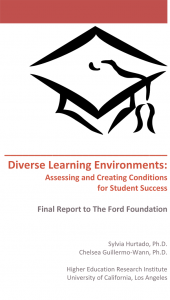Diverse Learning Environments

The challenge of higher education is to prepare students for a vision of the local and global society we aspire to become—one that is focused on advancing social progress and is equitable, interdependent, sustainable, innovative, and economically secure for the welfare of all. This new vision of society calls for equipping students with the values, skills, and knowledge to become complex thinkers and ethical decision–makers in a society currently plagued with conflict and inequality. It also calls for assessing where our students begin, how they grow and change, and how our educational practices contribute to undergraduate education goals that will achieve this vision. As postsecondary institutions enter an era of ”evidence-based“ practice, and take greater responsibility for monitoring student outcomes, we must also aim to assess the context of diverse learning environments that impact these outcomes. If we do not assess diverse learning environments, assessment instruments of student outcomes will simply document the cycle of disparities in educational outcomes (traced back to preparation prior to college) without identifying areas for improving student learning and development. This would be a disservice to students who have overcome significant obstacles and arrive at our doorsteps or ”portals“ to learn. Integrating assessments of student outcomes, the climate for diversity, and campus practices may be the best strategy to ensure all students are well-served to be successful and to maximize the benefits of diverse learning environments for citizenship in a diverse society.
The Diverse Learning Environments project will embark on a set of research and practice initiatives to address equity, diversity, and educational outcomes at multiple levels of analysis: student level assessment, at the institutional level in terms of assessment of the diverse learning environments, and at the multi-institutional comparisons at pilot institutions (including broad access campuses) as well as national comparison information that will be generated over the life of the project. Embedded in the development of each initiative are explicit ways to “scale up” the work so that many more individuals (researchers and educators) and institutions are engaged in maximizing the conditions for learning in diverse environments. All initiatives are connected with use of research for the improvement of practices that advance student success.
Post-Baccalaureate Experience, Success, and Transition
 More college freshmen than ever before are aspiring to postgraduate degrees, and interest in majoring in the biological and behavioral sciences (BBS) or in fields related to science, technology, engineering, and mathematics (STEM) has nearly doubled in the last 15 years, and interest in majoring in chemistry has made a complete recovery from a historic low 10 years ago (Pryor, Hurtado, Sáenz, Santos, & Korn, 2007). Over thirty years of National Institutes of Health (NIH), National Institute of General Medical Sciences (NIGMS), and National Science Foundation (NSF) program funding for students and institutions was intended to influence student career plans and prepare them for STEM and behavioral science research careers during college. This study seeks to address the unique college and graduate school experiences of underrepresented racial minority (URM) students with the ultimate goal of assisting institutions in reducing racial/ethnic disparities in college faculty, research scientists and engineers, and health career professionals engaged in research.
More college freshmen than ever before are aspiring to postgraduate degrees, and interest in majoring in the biological and behavioral sciences (BBS) or in fields related to science, technology, engineering, and mathematics (STEM) has nearly doubled in the last 15 years, and interest in majoring in chemistry has made a complete recovery from a historic low 10 years ago (Pryor, Hurtado, Sáenz, Santos, & Korn, 2007). Over thirty years of National Institutes of Health (NIH), National Institute of General Medical Sciences (NIGMS), and National Science Foundation (NSF) program funding for students and institutions was intended to influence student career plans and prepare them for STEM and behavioral science research careers during college. This study seeks to address the unique college and graduate school experiences of underrepresented racial minority (URM) students with the ultimate goal of assisting institutions in reducing racial/ethnic disparities in college faculty, research scientists and engineers, and health career professionals engaged in research.
Recent reports suggest that science degree completion and graduate studies leading to research careers are critical to national interests. It is important to identify and assess effective postsecondary contexts and interventions that promote diversity, access, and engagement in the sciences during college to not only retain students but also prepare science graduates for post-college pathways that lead to advanced studies and scientific research careers.
This line of inquiry is of further importance given that roughly half of those students who display an initial interest in majoring in science fields switch out of these programs within their first two years of undergraduate study, and very few non-science aspirants become science majors. The rates of science baccalaureate completion for underrepresented racial minority (African American, Hispanic/Latina/o, and Native American) students are even more dismal: only 24% of underrepresented students complete a bachelor’s degree in science in six years, compared to 40% of White students (Center for Institutional Data Exchange and Analysis, 2000).
Underrepresented racial minority (URM) STEM retention and preparation for graduate school are crucial steps in purposefully reversing the current trends and diversifying the scientific workforce. This project builds on earlier work that focused on the pre-college and college experiences of URM students in STEM and behavioral science (BBS) fields, extending this line of inquiry to examine students’ post-college pathways, including the link between undergraduate and graduate school experiences.
Spirituality in Higher Education
In 2003, we began a seven-year study examining how students change during the college years and the role that college plays in facilitating the development of their spiritual and religious qualities. Funded by the John Templeton Foundation, “Spirituality in Higher Education: Students’ Search for Meaning and Purpose,” is the first national longitudinal study of students’ spiritual growth.
It is our shared belief that the findings provide a powerful argument for the proposition that higher education should attend more to students’ spiritual development, because spirituality is essential to students’ lives.
Assisting students’ spiritual growth will help create a new generation who are more caring, more globally aware, and more committed to social justice than previous generations, while also enabling students to respond to the many stresses and tensions of our rapidly changing technological society with a greater sense of equanimity.

